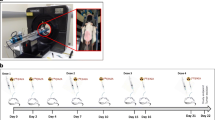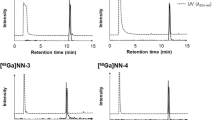Abstract
Tumor hypoxia, present in many human cancers, can lead to resistance to radiation and chemotherapy, is associated with a more aggressive tumor phenotype and is an independent prognostic factor of clinical outcome. It is therefore important to identify and localize tumor hypoxia in cancer patients. In the current study, serial microPET imaging was used to evaluate iodine-124-labeled iodo-azomycin-galactoside (124I-IAZG) (4.2-day physical half-life) as a hypoxia imaging agent in 17 MCa breast tumors and six FSaII fibrosarcomas implanted in mice. For comparison, another promising hypoxic-cell PET radiotracer, fluorine-18-labeled fluoro-misonidazole (18F-FMISO), was also imaged in the same tumor-bearing animals. Twelve animals were also imaged with 18F-labeled fluoro-deoxyglucose (18F-FDG). In addition, histological examination was performed, and direct measurement of tumor oxygenation status carried out with the Oxylite probe system. Two size groups were used, relatively well-oxygenated tumors in the range of 80–180 mg were designated as small, and those >300 mg and highly hypoxic, as large. Based on the data from 11 MCa and six FSaII tumors, both 124I-IAZG and 18F-FMISO images showed high tracer uptake in the large tumors. In 18F-FMISO images at 1, 3–4, and 6–8 h post-injection (p.i.), there was considerable whole-body background activity. In contrast, 124I-IAZG imaging was optimal when performed at 24–48 h p.i., when the whole-body background had dissipated considerably. As a result, the 124I-IAZG images at 24–48 h p.i. had higher tumor to whole-body activity contrast than the 18F-FMISO images at 3–6 h p.i. Region-of-interest analysis was performed as a function of time p.i. and indicated a tumor uptake of 5–10% (of total-body activity) for FMISO at 3–6 h p.i., and of ~17% for IAZG at 48 h p.i. This was corroborated by biodistribution data in that the tumor-to-normal tissue (T/N, normal tissues of blood, heart, lung, liver, spleen, kidney, intestine, and muscle) activity ratios of IAZG at 24 h p.i. was 1.5–2 times higher than those of FMISO at 3 h p.i., with the exception of stomach. Statistical analysis indicated that these differences in T/N ratios were significant. The small tumors were visualized in the 18F-FDG images, but not in the 124I-IAZG or 18F-FMISO images. This was perhaps due to the combined effect of a smaller tumor volume and a lower hypoxic fraction. Oxylite probe measurement indicated a lesser proportion of regions with pO2<2.5 mmHg in the small tumors (e.g., pO2 was <2.5 mmHg in 28% and 67% of the data in small and large FSaII tumors, respectively), and the biodistribution data showed lower uptake of the tracers in the small tumors than in the large tumors. In the first study of its kind, using serial microPET imaging in conjunction with biodistribution analysis and direct probe measurements of local pO2 to evaluate tumor hypoxia markers, we have provided data showing the potential of 124I-IAZG for hypoxia imaging.








Similar content being viewed by others
References
Thomlinson R, Gray L. The histological structure of some human lung cancers and the possible implications for radiotherapy. Br J Cancer 1955; 9:539–549.
Nordsmark M, Overgaard M, Overgaard J. Pretreatment oxygenation predicts radiation response in advanced squamous cell carcinoma of the head and neck. Radiother Oncol 1996; 41:31–39.
Hockel M, Knoop C, Schlenger K, Vorndran B, Baussmann E, Mitze M, Knapstein PG, Vaupel P. Intratumoral pO2 predicts survival in advanced cancer of the uterine cervix. Radiother Oncol 1993; 26:45–50.
Brizel DM, Scully SP, Harrelson JM, Layfield LJ, Bean JM, Prosnitz LR, Dewhirst MW. Tumor oxygenation predicts for the likelihood of distant metastases in human soft tissue sarcoma. Cancer Res 1996; 56:941–943.
Chapman JD, Engelhardt EL, Stobbe CC, Schneider RF, Hanks GE. Measuring hypoxia and predicting tumor radioresistance with nuclear medicine assays. Radiother Oncol 1998; 46:229–237.
Urtasun RC, Parliament MB, McEwan AJ, Mercer JR, Mannan RH, Wiebe LI, Morin C, Chapman JD. Measurement of hypoxia in human tumours by non-invasive SPECT imaging of iodoazomycin arabinoside. Br J Cancer 1996; 74 Suppl 27:S209–S212.
Ballinger JR. Imaging hypoxia in tumors. Semin Nucl Med 2001; 31:321–329.
Rasey JS, Koh WJ, Evans ML, Peterson LM, Lewellen TK, Graham MM, Krohn KA. Quantifying regional hypoxia in human tumors with positron emission tomography of [18F]fluoromisonidazole: a pretherapy study of 37 patients. Int J Radiat Oncol Biol Phys 1996; 36:417–428.
Lehtiö K, Oikonen V, Gronroos T, Eskola O, Kalliokoski K, Bergman J, Solin O, Grenman R, Nuutila P, Minn H. Imaging of blood flow and hypoxia in head and neck cancer: initial evaluation with [(15)O]H(2)O and [(18)F]fluoroerythronitroimidazole PET. J Nucl Med 2001; 42:1643–1652.
Evans SM, Kachur AV, Shiue CY, Hustinx R, Jenkins WT, Shive GG, Karp JS, Alavi A, Lord EM, Dolbier WR Jr, Koch CJ. Noninvasive detection of tumor hypoxia using the 2-nitroimidazole [18F]EF1. J Nucl Med 2000; 41:327–336.
Evans SM, Hahn SM, Magarelli DP, Koch CJ. Hypoxic heterogeneity in human tumors: EF5 binding, vasculature, necrosis, and proliferation. Am J Clin Oncol 2001; 24:467–472.
Dolbier WR Jr, Li AR, Koch CJ, Shiue CY, Kachur AV. [18F]-EF5, a marker for PET detection of hypoxia: synthesis of precursor and a new fluorination procedure. Appl Radiat Isot 2001; 54:73–80.
Piert M, Machulla HJ, Reichel G, Ziegler S, Kumar P, Schwaiger M, Wiebe LI.18F labeled fluoroazomycin arabinoside (FAZA): imaging tumor hypoxia with improved biokinetics. J Nucl Med 2002; 43 (Suppl):278P.
Lewis JS, McCarthy DW, McCarthy TJ, Fujibayashi Y, Welch MJ. Evaluation of64Cu-ATSM in vitro and in vivo in a hypoxic tumor model. J Nucl Med 1999; 40:177–183.
Chao KS, Bosch WR, Mutic S, Lewis JS, Dehdashti F, Mintun MA, Dempsey JF, Perez CA, Purdy JA, Welch MJ. A novel approach to overcome hypoxic tumor resistance: Cu-ATSM-guided intensity-modulated radiation therapy. Int J Radiat Oncol Biol Phys 2001; 49:1171–1182.
Dehdashti F, Mintun M, Lewis J, Bradley J, Govidan R, Laforest R, Welch M, Siegel B. In vivo assessment of tumor hypoxia in lung cancer with60Cu-ATSM. Eur J Nucl Med Mol Imaging 2003; 30:844–850.
Dehdashti F, Grigsby P, Mintun M, Lewis J, Siegel B, Welch M. Assessing tumor hypoxia in cervical cancer by positron emission tomography with60Cu-ATSM: relationship to therapeutic response-a preliminary report. Int J Radiat Oncol Biol Phys 2003; 55:1233–1238.
Chapman J, Lee J, Meeker B. Adduct formation by 2-nitroimidazole drugs in mammalian cells: optimization of markers for tissue oxygenation. In: Adams G, ed. Selective activation of drugs by redox processes. New York: Plenum Press; 1990:313–323.
Seddon BM, Honess DJ, Vojnovic B, Tozer GM, Workman P. Measurement of tumor oxygenation: in vivo comparison of a luminescence fiber-optic sensor and a polarographic needle electrode in the P22 tumor. Radiat Res 2001; 155:837–846.
Urano M, Chen Y, Humm J, Koutcher JA, Zanzonico P, Ling C. Measurements of tissue oxygen tension using a time-resolved luminescence-based optical Oxylite probe: comparison with a paired survival assay. Radiat Res 2002; 167–173.
Cherif A, Yang DJ, Tansey W, Kim EE, Wallace S. Rapid synthesis of 3-[18F]fluoro-1–2-(2’-nitro-imidazolyl)-2-propranol([18F]fluoromisonidazole). Pharm Res 1994; 11:466–469.
Schneider R, Englehardt E, Stobbe C, Fenning M, Chapman J. The synthesis and radiolabeling of novel markers of tissue hypoxia of the iodinated azomycin nucleoside class. J Label Compd Radiopharm 1997; XXXIX:541–557.
Rasey JS, Koh WJ, Grierson JR, Grunbaum Z, Krohn KA. Radiolabelled fluoromisonidazole as an imaging agent for tumor hypoxia. Int J Radiat Oncol Biol Phys 1989; 17:985–991.
Iyer R, Haynes P, Schneider R, Movsas B, Chapman J. Marking hypoxia in rat prostate carcinomas with β-d-[125I] azomycin galactopyranoside and [99mTc]HL-91: correlation with microelectrode measurements. J Nucl Med 2001; 42:337–344.
Liu KJ, Bacic G, Hoopes PJ, Jiang J, Du H, Ou LC, Dunn HF, Swartz HM. Assessment of cerebral pO2 by EPR oximetry in rodents: effects of anesthesia, ischemia, and breathing gas. Brain Res 1995; 685:91–98.
Menke H, Vaupel P. Effect of injectable or inhalational anesthetics and of neuroleptic neuroleptanalgesic and sedative agents on tumor blood flow. Radiat Res 1988; 114:64–76.
Pentlow KS, Graham MC, Lambrecht RM, Cheung NK, Larson SM. Quantitative imaging of I-124 using positron emission tomography with applications to radioimmunodiagnosis and radioimmunotherapy. Med Phys 1991; 18:357–366.
Pentlow KS, Graham MC, Lambrecht RM, Daghighian F, Bacharach SL, Bendriem B, Finn RD, Jordan K, Kalaigian H, Karp JS, Robeson WR, Larson SM. Quantitative imaging of iodine-124 with PET. J Nucl Med 1996; 37:1557–1562.
Acknowledgements
This work was supported in part by RO1 CA84596 and R24 CA83084 from the NCI, National Institutes of Health, USA.
Author information
Authors and Affiliations
Corresponding author
Rights and permissions
About this article
Cite this article
Zanzonico, P., O’Donoghue, J., Chapman, J.D. et al. Iodine-124-labeled iodo-azomycin-galactoside imaging of tumor hypoxia in mice with serial microPET scanning. Eur J Nucl Med Mol Imaging 31, 117–128 (2004). https://doi.org/10.1007/s00259-003-1322-y
Published:
Issue Date:
DOI: https://doi.org/10.1007/s00259-003-1322-y




